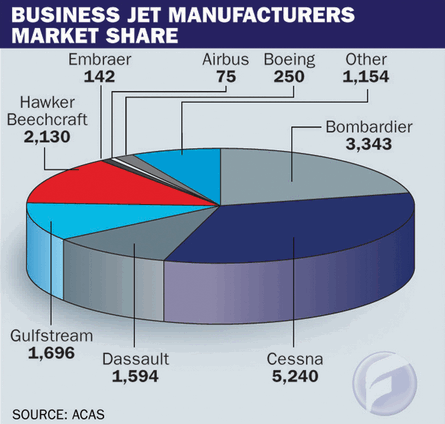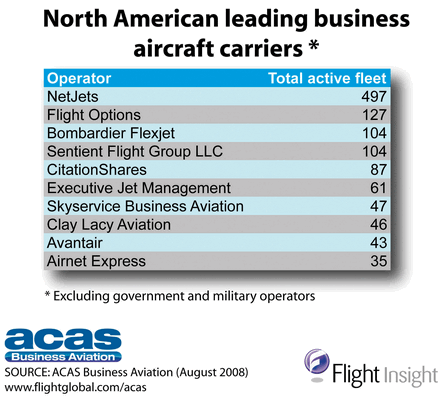Are the good times are finally over for business aviation? September has arguably been a watershed for global capitalism, on which the success of business aviation is almost entirely dependent.
The collapse of major financial institutions on both sides of the Atlantic has rocked the markets, prompting the most severe financial rescue packages in living memory. An uneasy calm has been restored, but economic well-being in many Western economies, notably the US, is uncertain.
But business aviation manufacturers have built up substantial order backlogs that should cushion any immediate impact from the financial debacle. Furthermore, they have cleverly shifted their sales focus from America – traditionally the biggest buyer – to international markets. This strategy has paid dividends as these countries now account for more than 50% of new aircraft sales.
“Determining the health of the business jet market can be hard,” says aerospace analyst Richard Aboulafia. “Business jet backlogs aren’t at all transparent, and this market, like any aviation market, can turn on a dime.”
US corporate profits – the key long-lead metric – have lost their importance, he says, since the international non-US market has gone from 25% to 55% of demand in recent years. “However, given broader economic concerns and the credit situation, we’re almost certainly heading for a deliveries peak in the next 18 months and a downturn after 2010.”
 |
|---|
Continued growth in the worldwide corporate aircraft fleet over the past 12 months has persuaded the increasing pool of cost-conscious operators to switch to these more economical business aircraft. The worldwide corporate jet fleet has, however, seen double this rate of growth, climbing by more than 4% from 14,989 to 15,624 aircraft in 12 months.
Flight International’s 2008 corporate aircraft census - a barometer for the business aviation industry and compiled by Flight’s ACAS database - reflects the industry’s strong growth in the 12 months from 31 July 2007. It reveals the world’s active turbine corporate aircraft fleet has climbed over 3% to 26,095 jets and turboprops, compared with 25,312 aircraft in last year’s census.
The total reflects around 900 out-of-production types that have been removed from the census this year having been parked, sold for spares or moved into a non-corporate/business/VIP role since the last listing. Turboprops continued their resurgence, with the fleet climbing by 2% from 10,267 to 10,472. They have become increasingly popular due to escalating fuel prices that have persuaded the increasing pool of cost-conscious operators to switch to more economical business aircraft. The worldwide corporate jet fleet has, however, seen double this rate of growth, climbing by more than 4% from 14,989 to 15,624 aircraft in 12 months.
 |
|---|
Embraer again recorded the largest percentage increase, albeit from a smaller installed base, with a 25% rise in its jet fleet from 113 to 142 business jets, attributable to sales of its Legacy 600 business jet.
Production of the super-midsize aircraft will climb to a peak of 38 aircraft this year, although from 2010 numbers are expected to fall to 24 aircraft a year. This will have little impact on Embraer’s overall production scale in the coming years as its new business jets enter service with bulging backlogs, including more than 750 for the Phenom 100 very light jet and Phenom 300 light jet.
Cessna plans to deliver around 470 Citations this year and over 530 next year – boosted by the service entry of its newest light jet, the CJ4 – although the manufacturer expects the market to soften after 2009. Cessna is diligently working to bring its new large-cabin Columbus 850 to market in 2012. It says it has already smashed its order target for the aircraft within months of its launch earlier this year.
Gulfstream has seen its in-service business jet fleet rise by nearly 9% from 1,559 to 1,680, including a 160% increase in the midsize G150 inventory to 49 aircraft, a 33% increase in the ultra-long-range G550 fleet to 174 aircraft and a 25% boost to its G200 tally to 168 super-midsize jets.
Bombardier’s inventory of in-production business has climbed by 200 aircraft in the past 12 months, although its total in-service fleet has risen by just over 1% to 3,343 business jets, according to ACAS.
 |
|---|
The super-midsize Challenger 300 fleet has increased by 56 aircraft to 197, while Challenger 605 numbers have rocketed from three to 35. The midsize Learjet 60XR makes its census debut with 26 aircraft, while the super light Learjet 45XR fleet has risen by 31 aircraft to 113. At the top of the Bombardier range the super-large Global 5000 and ultra-long-range XRS fleets have risen by 18 and 22 aircraft respectively in the past 12 months.
Bombardier’s out-of-production fleet has shrunk, however, by 119 as aircraft have been parked, sold for parts or removed from the census. The Learjet 35A has seen the sharpest fall in numbers from 464 in 2007 to 369 today.
Like Bombardier, Dassault has seen its Falcon business jet tally rise by only a small number. Although deliveries of its popular in-service models have risen by 65 aircraft to 1,594, the declining numbers of out-of-production aircraft have offset the French airframer’s corporate inventory, which shows an overall hike of only three aircraft. The corporate Falcon 20 fleet shows the sharpest decline, of 48 aircraft.
The French company’s philosophy of pitching its product line at the top end of the market continued to reap rewards as demand for Falcons is soaring. The large-cabin 2000EX fleet has risen by nearly 25% to 141, the 900DX from 10 to 18, the long-range 900EX from 177 to 195 and the Falcon 7X from six to 11 aircraft.
Production of the ultra-long-range business jet has begun in earnest, with 40 aircraft earmarked for delivery next year and 42 in 2010. The census also shows a three-aircraft rise in the Falcon 50EX tally since last year’s census as the last of the super-midsize business jets entered service.
At the top end of the business jet market, Airbus and Boeing continue to expand their fleets of VIP-configured airliners. Boeing has seen its fleet rise by only four aircraft, to 250, offset by the fall of five aircraft in the VIP 727 and 757 fleet. BBJ numbers have risen by six aircraft to 102 – 89 BBJs and 13 BBJ 2s. The upward delivery trend looks set to continue for the BBJ as it introduces next year its 737-900-based BBJs and VIP 747-8 and 787-8/9. But the impact of these models on numbers will be negligible as the widebodies are in the main being acquired by customers seeking to replace older Boeing types such as the 747.
Airbus’s Corporate Jetliner fleet has risen by seven aircraft to 75, boosted by a rise in A319 Airbus Corporate Jetliner and A318 Elite fleets by nine and two aircraft, respectively. Airbus has around 30 orders and commitments.
Hawker Beechcraft boasts one of the broadest product spans and has seen its fleet climb since the last census by 113 aircraft to 2,130. The biggest increases are recorded by the Premier IA light jet with a 75% climb to 109 aircraft, accompanied by a 22% increase in 400XP numbers to 199 aircraft and a similar rise in 850XP numbers to 83. The service entry this year of the Hawker 900XP – a longer-range derivative of the 850XP making its census debut – boosts Hawker Beechcraft’s tally by 53 aircraft. The inventory is set for another injection in the coming months as deliveries of the super-midsize Hawker 4000 begin in earnest along with the shorter-range 750.
Hawker Beechcraft also retains its dominance in the turboprop market due to the unequalled popularity of the King Air. This ubiquitous twin turboprop represents half the world’s twin-turboprop fleet at 5,501 aircraft. The in-production fleet has risen by 129 aircraft. This includes 48 350s and 38 C90GTs, boosting the fleet to 556 and 119 aircraft, respectively. The B200GT, which makes its census debut, boosts the tally by 43. But the total King Air inventory has fallen by 39 aircraft as earlier models such as the B200, C12C and UC12B are removed from corporate service.
Italy’s Piaggio continues to see strong demand for its Avanti II, a revamp of the 20-year-old P180 twin-turboprop, with the inventory up by 28% since the last census to 161 aircraft. Demand is particularly strong from fractional operators and Piaggio plans to boost annual production this year from 22 to more than 30 aircraft next year.
Single-engined turboprops are making significant fleet gains and manufacturers are responding to their resurgence, introducing upgrades to increase their appeal.
Heading the single-engined aircraft inventory tally is Pilatus, whose PC-12 fleet has climbed 7% to 750 aircraft, boosted by the popularity of the Next Generation PC-12. The Swiss manufacturer plans to deliver 96 aircraft this year, up four on the previous year, and 105 in 2009.
The decision by Piper Aircraft to install the Avidyne Entegra integrated flightdeck as standard has boosted the Meridian single-turboprop fleet by 60 aircraft since the last census to 1,403. Piper moved into the jet market for the first time two years ago with the single-engined Piper Jet, which is scheduled to enter service in 2011.
Bowing to market pressure, EADS Socata has introduced a glass-cockpit upgrade for its single-turboprop TBM850. The first Garmin G1000-equipped aircraft was handed over to a US customer in January. Fleet numbers have continued to climb since the last census, from 365 to 405 aircraft, and the airframer plans to deliver 60 850s this year. Socata is now being offloaded by EADS to French aerospace group Daher.
The next 12 months is expected to nudge the single-turboprop inventory higher, with Quest Aircraft expected to ramp up deliveries of its 10-seat Kodiak this quarter. The competitor for Cessna’s Caravan has a three-year backlog. Cessna has also seen its corporate 208 Caravan tally climb by seven aircraft since the last census, although the overall inventory has slipped from 558 to 550 over the same period as older models have exited the listing.
Success for single-engine turboprops has been at the expense of very light jets. Only two VLJ programmes have entered service as funding constraints have hampered development of models such as the Aviation Technology Group Javelin, production of which is suspended, and the Adam Aircraft A700, which has been acquired by Russian company AAI Acquisition.
Nonetheless, the first two entrants have made significant fleet gains. Cessna has seen its Citation Mustang fleet climb by 80 aircraft to 93, while Eclipse Aviation’s Eclipse 500 tally has escalated to 188 from a 2007 census total of 21.
Source: Flight International























